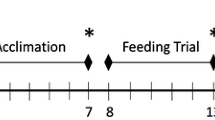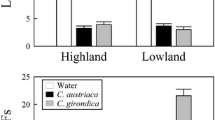Abstract
Learned avoidance can allow animals to survive the introduction of noxious prey. The effectiveness of aversion learning can depend on the intensity of the stimulus. The red imported fire ant, Solenopsis invicta, is a novel prey of the eastern fence lizard, Sceloporus undulatus, but can prove lethal especially to juvenile fence lizards. Thus, avoiding consumption of fire ants would increase survival for juveniles. We tested whether juvenile lizards would exhibit learned aversion of fire ants, and whether aversion would be longer lasting following exposure to greater numbers of fire ants. Lizards were exposed to one of three 8-ant treatments with varying relative proportions of fire ants for 5 days: (1) 100% fire ants, (2) 50% fire ants and 50% native ants, and (3) 0% fire ants (8 native ants). Juveniles in the 100% fire ant treatment showed clear aversion learning, consuming nearly two-thirds fewer fire ants after the first trial day. Juveniles exposed to the 50% fire ant treatment, consumed slightly fewer fire ants after day 1 of the trial, but recovered by day 5. Juveniles that received native ants only did not alter their consumption of ants over time. These results suggest that juveniles show species-specific aversion to fire ants, but this was dependent upon stimulus strength. When presented with both fire ants and native ants, lizards reduced their consumption of both species. Investigating whether exposure to noxious invasive prey alters the consumption of native prey would provide insight into long-term impacts of invasive species.


Similar content being viewed by others
References
Brower LP, Brower JVZ (1964) Birds, butterflies and plant poisons: a study in ecological chemistry. Zool N Y 49:137–159
Buren WF (1972) Revisionary studies on the taxonomy of the imported fire ants. J Ga Entomol Soc 7:1–26
Callcott AMA, Collins HL (1996) Invasion and range expansion of imported fire ants (Hymenoptera: Formicidae) in North America from 1918–1995. Fla Entomol 79:240–251. https://doi.org/10.2307/3495821
Davis TS (2005) Pyramid ants. South Carolina State Documents Depository. http://hdl.handle.net/10827/10994. Accessed 25 July 2018
Dawkins R, Krebs JR (1979) Arms races between and within species. Proc R Soc Lond B Biol Sci 205:489–511. https://doi.org/10.1098/rspb.1979.0081
Demarco VG, Drenner RW, Ferguson GW (1985) Maximum prey size of an Insectivorous Lizard, Sceloporus undulatus garmani. Copeia 1985:1077–1080. https://doi.org/10.1098/rspb.1979.0081
Faure PA, Barclay RM (1992) The sensory basis of prey detection by the long-eared bat, Myotis evotis, and the consequences for prey selection. Anim Behav 44:31–39. https://doi.org/10.1016/S0003-3472(05)80751-1
Freidenfelds NA, Langkilde T (2009) Natural history notes: Sceloporus undulatus (eastern fence lizard) diet. Herpetol Rev 40:439
Freidenfelds NA, Robbins TR, Langkilde T (2012) Evading invaders: the effectiveness of a behavioral response acquired through lifetime exposure. Behav Ecol 23:659–664. https://doi.org/10.1093/beheco/ars011
Garcia J, Lasiter PS, Bermudez-Rattoni F, Deems DA (1985) A general theory of aversion learning. Ann N Y Acad Sci 443:8–21. https://doi.org/10.1111/j.1749-6632.1985.tb27060.x
Greenlees MJ, Phillips BL, Shine R (2010) Adjusting to a toxic invader: native Australian frogs learn not to prey on cane toads. Behav Ecol 21:966–971. https://doi.org/10.1093/beheco/arq095
Gurevitch J, Padilla DK (2004) Are invasive species a major cause of extinctions? Trends Ecol Evol 19:470–474. https://doi.org/10.1016/j.tree.2004.07.005
Hargrove WW, Hoffman FM (1999) Using multivariate clustering to characterize ecoregion borders. Comput Sci Eng 1:18–25. https://doi.org/10.1109/5992.774837
Herr MW, Robbins TR, Centi A, Thawley CJ, Langkilde T (2016) Irresistible ants: exposure to novel toxic prey increases consumption over multiple temporal scales. Oecologia 181:749–756. https://doi.org/10.1007/s00442-016-3596-3
Holmes RA, Gibson RN (1986) Visual cues determining prey selection by the turbot, Scophthalmus maximus L. J Fish Biol 29:49–58. https://doi.org/10.1111/j.1095-8649.1986.tb04998.x
Ingle DJ (1990) Visually elicited evasive behavior in frogs. Bioscience 40:284–291. https://doi.org/10.2307/1311265
Langkilde T (2009a) Invasive fire ants alter behavior and morphology of native lizards. Ecology 90:208–217. https://doi.org/10.1890/08-0355.1
Langkilde T (2009b) Holding ground in the face of invasion: native fence lizards (Sceloporus undulatus) do not alter their habitat use in response to introduced fire ants (Solenopsis invicta). Can J Zool 87:626–634. https://doi.org/10.1139/Z09-053
Langkilde T, Freidenfelds NA (2010) Consequences of envenomation: red imported fire ants have delayed effects on survival but not growth of native fence lizards. Wildl Res 37:566. https://doi.org/10.1071/WR10098
Llewelyn J, Schwarzkopf L, Alford R, Shine R (2010) Something different for dinner? Responses of a native Australian predator (the keelback snake) to an invasive prey species (the cane toad). Biol Invasions 12:1045–1051. https://doi.org/10.1007/s10530-009-9521-5
Logue AW, Ophir I, Strauss KE (1981) The acquisition of taste aversions in humans. Behav Res Ther 19:319–333. https://doi.org/10.1016/0005-7967(81)90053-X
Markin GP, O’Neal J, Dillier J (1975) Foraging tunnels of the red imported fire ant, Solenopsis invicta (Hymenoptera: Formicidae). J Kansas Entomol Soc 1975:83–89
Mery F, Burns JG (2010) Behavioural plasticity: an interaction between evolution and experience. Evol Ecol 24:571–583. https://doi.org/10.1007/s10682-009-9336-y
Nowlis GH (1974) Conditioned stimulus intensity and acquired alimentary aversions in the rat. J Comp Physiol Psychol 86:1173. https://doi.org/10.1037/h0037644
Parker WS (1994) Demography of the fence lizard, Sceloporus undulatus, in northern Mississippi. Copeia 1994:136–152. https://doi.org/10.2307/1446680
Pelchat ML, Rozin P (1982) The special role of nausea in the acquisition of food dislikes by humans. Appetite 3:341–351. https://doi.org/10.1016/S0195-6663(82)80052-4
Pelchat ML, Grill HJ, Rozin P, Jacobs J (1983) Quality of acquired responses to tastes by Rattus norvegicus depends on type of associated discomfort. J Comp Psychol 97:140. https://doi.org/10.1037/0735-7036.97.2.140
Phillips BL, Shine R (2006a) An invasive species induces rapid adaptive change in a native predator: cane toads and black snakes in Australia. Proc R Soc B Biol Sci 273:1545–1550. https://doi.org/10.1098/rspb.2006.3479
Phillips BL, Shine R (2006b) Adapting to an invasive species: toxic cane toads induce morphological change in Australian snakes. Proc Natl Acad Sci USA 101:17150–17155. https://doi.org/10.1073/pnas.0406440101
Phillips BL, Shine R (2006c) Allometry and selection in a novel predator–prey system: Australian snakes and the invading cane toad. Oikos 112:122–130. https://doi.org/10.1111/j.0030-1299.2006.13795.x
Pintor L, Byers J (2015) Do native predators benefit from non-native prey? Ecol Lett 18:1174–1180. https://doi.org/10.1111/ele.12496
Robbins TR, Langkilde T (2012) The consequences of lifetime and evolutionary exposure to toxic prey: changes in avoidance behaviour through ontogeny. Evol Biol 25:1937–1946. https://doi.org/10.1111/j.1420-9101.2012.02583.x
Robbins TR, Freidenfelds NA, Langkilde T (2013) Native predator eats invasive toxic prey: evidence for increased incidence of consumption rather than aversion-learning. Biol Invasions 15:407–415. https://doi.org/10.1007/s10530-012-0295-9
Rozin P, Zellner D (1985) The role of Pavlovian conditioning in the acquisition of food likes and dislikes. Ann N Y Acad Sci 443:189–202. https://doi.org/10.1111/j.1749-6632.1985.tb27073.x
Tingley R, Ward-Fear G, Schwarzkopf L, Greenlees MJ, Phillips BL, Brown G, Strive T (2017) New weapons in the Toad Toolkit: a review of methods to control and mitigate the biodiversity impacts of invasive cane toads (Rhinella marina). Q Rev Biol 92:123–149. https://doi.org/10.1086/692167
Vitousek PM, D’Antonio CM, Loope LL, Westbrooks R (1996) Biological invasions as global environmental change. Am Sci 84:468
Webb JK, Brown GP, Child T, Greenlees MJ, Phillips BL, Shine R (2008) A native dasyurid predator (common planigale, Planigale maculata) rapidly learns to avoid a toxic invader. Austral Ecol 33:821–829. https://doi.org/10.1111/j.1442-9993.2008.01847.x
Webb J, Somaweera R, Brown G, Shine R (2011) Hatchling Australian freshwater crocodiles rapidly learn to avoid toxic invasive cane toads. Behaviour 148:501–517. https://doi.org/10.1163/000579511X565763
Zuk M, Bastiaans E, Langkilde T, Swanger E (2014) The role of behaviour in the establishment of novel traits. Anim Behav 92:333–344. https://doi.org/10.1016/j.anbehav.2014.02.032
Acknowledgements
The authors thank K. MacLeod, D. Ensminger, and N. Freidenfelds for their assistance in the field, the Langkilde lab members for feedback on the project, and Joel Martin and the staff of the Solon Dixon Forestry Education Center for logistical support. The Pennsylvania State University Animal Care and Use Committee approved all experimental procedures, and the respective States permitted animal collection. This research was funded in part by the National Science Foundation (IOS 1456655; to TL).
Author information
Authors and Affiliations
Corresponding author
Additional information
Publisher's Note
Springer Nature remains neutral with regard to jurisdictional claims in published maps and institutional affiliations.
Rights and permissions
About this article
Cite this article
Venable, C.P., Adams, T.S. & Langkilde, T. Aversion learning in response to an invasive venomous prey depends on stimulus strength. Biol Invasions 21, 1973–1980 (2019). https://doi.org/10.1007/s10530-019-01949-3
Received:
Accepted:
Published:
Issue Date:
DOI: https://doi.org/10.1007/s10530-019-01949-3




